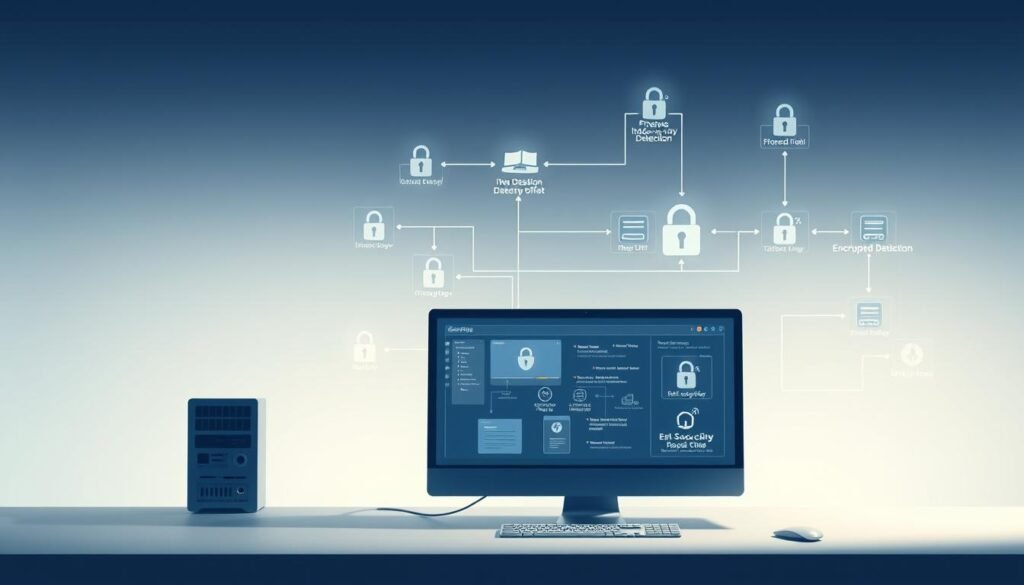In today’s digital world, cybersecurity development is key. We’re always looking for new ways to keep data safe and fight off cyber threats.
At Consac, we know effective IT security measures are essential. We use secure software solutions in our work. This helps lower the chance of cyber attacks and keeps our data safe.
If you have questions or want to share your thoughts, reach out to us at info@consac.dev. Your feedback is important to us. We’re here to help you understand IT security better.
Understanding IT Security and Its Importance

Cyber threats are growing fast. Knowing the basics of IT security is now more important than ever. We use digital tech a lot, so protecting our networks, data, and systems is key.
Overview of IT Security
IT security, or cybersecurity, is about keeping networks, devices, and data safe from harm. It’s vital in our connected world. Cyber threats are always there and changing.
Key Components of IT Security
IT security has several main parts:
- Network Security: It protects networks with both hardware and software.
- Application Security: It stops apps from being attacked by malware or unauthorized access.
- Data Security: It keeps digital data safe from unauthorized access, ensuring it’s private, safe, and available.
- Endpoint Security: It guards devices like laptops and phones against cyber threats.
These parts together make a strong IT security system that fights off many threats.
| Component | Description | Key Measures |
|---|---|---|
| Network Security | Protects network infrastructure | Firewalls, intrusion detection systems |
| Application Security | Secures applications | Secure coding practices, regular updates |
| Data Security | Protects data | Encryption, access controls |
Common Threats to IT Security
IT security faces many dangers, like malware, phishing, DoS attacks, and insider threats. Knowing these threats helps us fight back.
For any questions or comments, reach out to us at info@consac.dev.
The Evolution of Cybersecurity Development

Cybersecurity has grown a lot over time. It’s shaped by big events, new tech, and trends. Knowing how it’s changed helps us get ready for what’s next.
Historical Context of Cybersecurity
Cybersecurity started with the first computers and viruses. The 1980s brought the first computer viruses, simple but a start. As tech got better, so did the threats.
In the 1990s and early 2000s, the internet grew. This made it easier for hackers to find targets. New kinds of malware, like Trojans and spyware, showed we needed better protection.
- Firewalls and intrusion detection systems were developed.
- Encryption became key for keeping data safe.
- Incident response teams were set up.
These steps were big for cybersecurity. They helped create today’s defense plans.
Emerging Trends in Cybersecurity
Cybersecurity keeps changing fast, thanks to artificial intelligence (AI) and machine learning (ML). These tools help us understand threats better and respond faster.
Some big trends now include:
- AI and ML for predicting threats and finding them early.
- The rise of the Internet of Things (IoT) and its security needs.
- Cloud security becoming more important as more data goes online.
Looking ahead, cybersecurity will keep being key in fighting off many threats. For any questions or to share thoughts, email us at info@consac.dev.
Secure Software Solutions: Definition and Scope

Secure software solutions are key in keeping software safe. As we use software more, making it secure is more important than ever.
What Constitutes a Secure Software Solution?
A secure software solution is made with security in mind. It uses secure coding practices to stop vulnerabilities. This means security is part of every step, from design to deployment.
Key parts of a secure software solution are:
- Secure coding techniques to minimize vulnerabilities
- Regular security audits and assessments
- Implementation of secure communication protocols
- Data encryption and access controls
Importance of Secure Software Development Life Cycle
The secure software development life cycle (SSDLC) adds security to each step of making software. It helps find and fix security issues early. This saves time and money later.
For any questions or feedback on secure software solutions, email us at info@consac.dev. We aim to help organizations make secure software that fights off cyber threats.
Best Practices for Secure Software Development

To fight off cyber threats, it’s key to follow secure software development best practices. We add security to every step of making software. This helps lower the chance of security breaches and keeps our software safe.
Employing Secure Coding Techniques
Secure coding is the base for making strong and safe software. We use methods like checking user input, handling errors safely, and following coding rules. These steps help stop common threats like SQL injection and XSS attacks.
- Validate user inputs to prevent malicious data from entering the system.
- Implement secure error handling mechanisms to avoid revealing sensitive information.
- Follow secure coding guidelines to ensure consistency and security across the development team.
Regular Security Audits and Assessments
Doing regular security checks and reviews is key to finding vulnerabilities and meeting security standards. We do deep reviews to check our software’s security, find weak spots, and fix them to lower risks.
| Assessment Type | Description | Frequency |
|---|---|---|
| Vulnerability Assessment | Identifies possible vulnerabilities in the software. | Quarterly |
| Penetration Testing | Tests the software’s defenses by simulating cyber attacks. | Bi-Annually |
| Compliance Audit | Checks if the software follows security standards and laws. | Annually |
Security Training for Developers
Training developers on security is essential. We teach them about secure coding, managing vulnerabilities, and new threats. This keeps them updated with the latest security info.
For any questions or feedback, reach out to us at info@consac.dev. By following these best practices, we make sure our software is secure. This protects our users and keeps their trust.
The Integration of IT Development and Cybersecurity

Cybersecurity and IT development are now one thing. They work together to make software safe. As we use more technology, we need to join these two areas more than ever.
Collaborative Approaches to Software Development
To join these areas, we must work together. This means:
- Cross-functional teams: We need teams that include IT developers, cybersecurity experts, and others. This way, security is part of every step in making software.
- Secure development lifecycle: We should have a cycle that checks for security often. This includes audits, checking for weaknesses, and testing how well software can withstand attacks.
- Continuous integration and continuous deployment (CI/CD): Using CI/CD helps keep security strong as software is made.
Benefits of Cross-Disciplinary Teams
Teams that mix different skills have big advantages. They include:
- Improved security: When we mix cybersecurity into making software, we can spot and fix threats better.
- Enhanced collaboration: Teams with different skills work better together. This leads to better results and solving problems faster.
- Innovative solutions: Mixing different views and skills can lead to new ideas. Ideas that might not come from just one area.
For any questions or comments, please reach out to us at info@consac.dev. By combining IT development and cybersecurity, we can make the digital world safer for all.
Cybersecurity Frameworks and Standards

In the world of cybersecurity, frameworks and standards are key to protecting our digital world. As we work on making software safer, it’s important to know and use these frameworks. This helps us stay strong against cyber threats.
Overview of Common Frameworks
Cybersecurity frameworks give us a clear way to handle and lower cybersecurity risks. Some top frameworks include:
- NIST Cybersecurity Framework: Made by the National Institute of Standards and Technology, it offers a full plan for managing cybersecurity risks.
- ISO/IEC 27001: This international standard sets out what’s needed for an information security management system (ISMS).
- CIS Controls: The Center for Internet Security’s controls give a detailed guide for keeping safe from cyber threats.
These frameworks are flexible and fit different needs and industries. Using them helps make sure our cybersecurity is strong.
How Frameworks Enhance Security Measures
Cybersecurity frameworks make our security better by giving a clear, step-by-step way to manage risks. They help in many ways:
| Framework Benefit | Description |
|---|---|
| Risk Management | Frameworks help spot, check, and lessen cybersecurity risks. |
| Compliance | Many frameworks match up with rules, making it easier to follow them. |
| Best Practices | Frameworks use the best ways to keep things safe, setting a high standard for cybersecurity. |
If you have questions or want to share thoughts on cybersecurity frameworks and standards, email us at info@consac.dev. Using these frameworks helps us all improve our cybersecurity and keep our information safe.
Risk Management in Cybersecurity

In the world of cybersecurity, managing risks is key to keeping our digital world safe. Risk management is all about understanding, checking, and fixing risks to our IT systems.
Identifying and Assessing Risks
The first step is to find out what risks we face. We look closely at our IT setup to find weak spots that hackers might target. We use tools like threat intelligence to spot and check these risks.
Threat intelligence is very important here. It gives us info on new threats and how hackers work. This helps us get ready for possible attacks.
Mitigation Strategies for IT Projects
After finding and checking risks, we start to fix them. We use strategies to lower the chance or damage of a cyber attack. We pick the most important risks to tackle first.
| Mitigation Strategy | Description | Benefits |
|---|---|---|
| Implementing Secure Coding Practices | Ensuring that software development follows secure coding guidelines to prevent vulnerabilities. | Reduces the risk of exploitable vulnerabilities in software. |
| Regular Security Audits | Conducting periodic audits to identify and address security weaknesses. | Helps in early detection and remediation of security issues. |
| Employee Training and Awareness | Educating employees on cybersecurity best practices and the importance of vigilance. | Reduces the risk of human error leading to security breaches. |
If you have questions or want to share your thoughts, email us at info@consac.dev. Managing risks well is a never-ending job that needs constant watching and updating. By being proactive and informed, we can keep our digital world safe.
The Role of AI in Cybersecurity

Artificial Intelligence (AI) is changing how we fight cyber threats. It’s making our defenses stronger and quicker to react. This is key as we face the digital world’s challenges.
AI is changing how we manage cybersecurity. It’s not just about new tech; it’s a whole new way of defending against cyber attacks.
AI-Powered Security Tools
AI-powered tools are leading this change. They use machine learning to scan huge amounts of data. This helps spot threats we might miss.
Some big advantages of these tools include:
- Enhanced Threat Detection: AI finds threats fast, cutting down on damage.
- Predictive Analytics: AI looks at past data to guess future threats, helping us act early.
- Automated Response: AI handles simple threats, saving human time for harder problems.
Addressing Ethical Concerns with AI Use
AI in cybersecurity is great, but it also raises big questions. For example, how do we keep our data safe while using AI? We need to:
- Make sure AI decisions are clear and fair.
- Protect our data well to keep it safe.
- Set rules for using AI in a way that’s right.
This way, we can use AI to keep our systems safe and trusted. For more info or to share your thoughts, email us at info@consac.dev.
Regulatory Compliance and IT Security
Regulatory compliance is more than a legal rule; it’s key to strong IT security. In today’s digital world, following these rules is vital. It helps protect sensitive data and keeps our clients and stakeholders trusting us.
Key Regulations Impacting IT Development
Many regulations shape IT development, focusing on data protection and cybersecurity. For example, the GDPR in Europe and the CCPA in the U.S. have strict rules. To follow these, you need to understand them well and act fast to meet their demands.
Important parts of these rules include:
- Data minimization and accuracy
- Strong security to protect personal data
- Being clear about how data is used
- Allowing people to control their data
By focusing on these, companies can meet rules and improve their IT security.
Importance of Compliance in Cybersecurity
Following regulatory standards is key for good cybersecurity. It helps companies use the best ways to protect data, lowering the chance of attacks. It also shows they care about security, building trust with customers and partners.
As cybersecurity experts say, “Compliance is not just about avoiding fines; it’s about creating a culture of security within an organization.” This culture is important for spotting and fixing risks early.
If you have questions or need help with IT security and compliance, email us at info@consac.dev. We’re here to help organizations deal with the complex world of IT security and compliance.
Incident Response Planning in IT Development
Incident response planning is key in IT development. It covers preparation, response, and recovery. As we face cybersecurity challenges, a strong plan is vital to lessen security breach impacts.
Creating an Effective Incident Response Plan
A solid incident response plan is essential for any cybersecurity strategy. We must spot vulnerabilities, set up response protocols, and train teams. This means:
- Regular risk assessments to find threats.
- Clear protocols for incident detection and response.
- Training on roles and responsibilities during incidents.
By doing these, we can lower the risk and impact of security incidents. Effective incident response planning is an ongoing effort that needs constant improvement.
Importance of Communication During an Incident
Clear and timely communication is critical during a security incident. We must keep all stakeholders updated on the incident’s status and actions. This includes:
- A clear communication chain and channels.
- Regular updates to team members, management, and affected customers.
- Transparent yet controlled communication to avoid panic or leaks.
Effective communication during an incident helps manage the situation and keeps trust. For any questions or feedback on incident response planning, contact us at info@consac.dev.
Future Trends in IT Security and Software Development
The next decade will bring big changes to IT security and software development. As tech advances, knowing these trends is key to fighting cyber threats.
Predictions for the Next Decade
Several key trends will shape the future of IT security and software development. These include:
- Increased Adoption of AI and Machine Learning: AI-powered security tools will become more common, improving threat detection and response.
- Greater Emphasis on Cloud Security: Securing cloud infrastructure will be a top priority as more businesses move to the cloud.
- Rise of DevSecOps: Integrating security into the development process will become standard, making security a core part of software development.
These trends highlight the need to stay agile and informed against evolving cyber threats.
The Role of Big Data in Cybersecurity
Big data is becoming more critical in cybersecurity. It helps organizations analyze vast amounts of data to spot patterns and anomalies that might signal a cyber threat. This proactive approach allows businesses to:
- Enhance Threat Detection: Big data analytics can spot threats before they happen.
- Improve Incident Response: With big data insights, organizations can respond better to security incidents.
Experts say big data in cybersecurity marks a big shift towards proactive security. It helps organizations stay ahead of emerging threats.
“The future of cybersecurity lies in its ability to adapt and evolve. By leveraging big data and emerging technologies, we can create a more secure digital landscape.”
For any inquiries or feedback, please contact us at info@consac.dev.
Conclusion: Moving Towards Safer Digital Environments
Our journey in IT development and cybersecurity is just starting. Cybersecurity is always evolving, needing constant innovation and watchfulness to fight new threats.
Key Takeaways
This article showed how IT security protects our digital world. We talked about how cybersecurity has grown, and the best ways to make software safe. We also looked at how IT and cybersecurity work together.
Frameworks for cybersecurity, managing risks, and using AI to improve security were discussed too.
The Path Forward
Looking ahead, we must stay ahead in IT security. This means keeping up with new cybersecurity trends and working together between IT and security teams. For any questions or comments, reach out to us at info@consac.dev.

